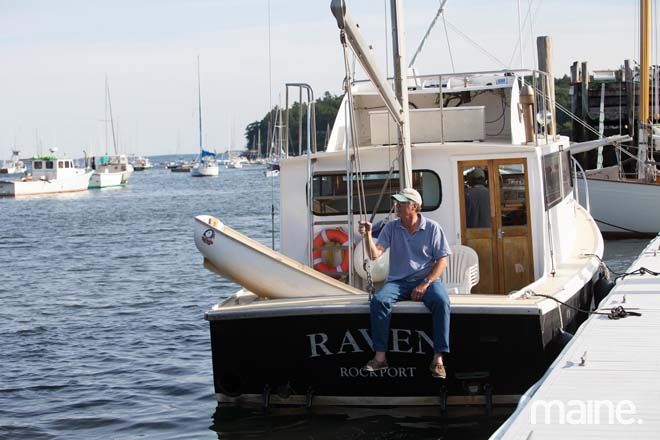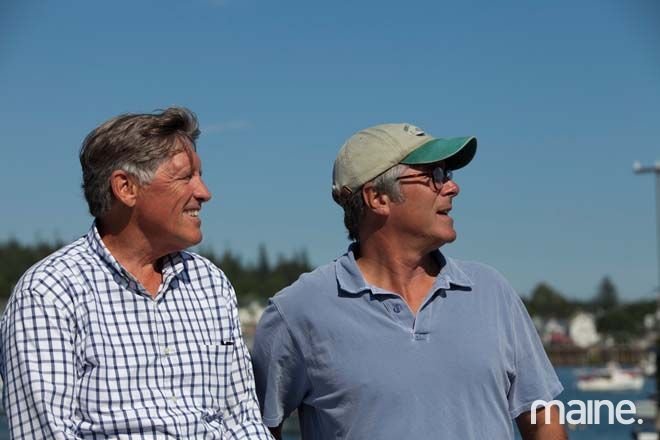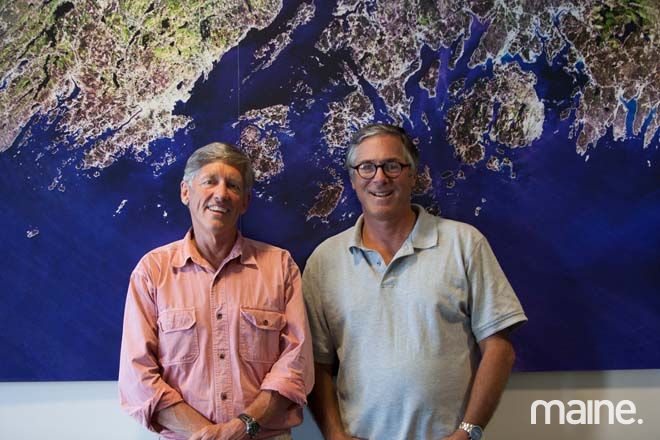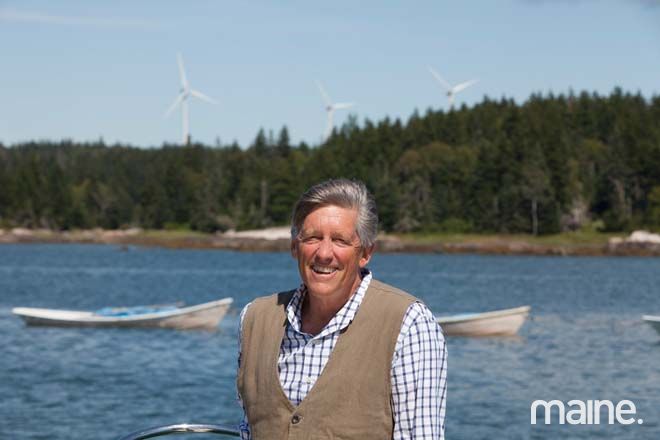Working the Waterfront
Philip Conkling, Peter Ralston and Three Decades of the Island Institute
By Sarah Braunstein, maine. magazine, October 2012
Photographs by Peter Ralston
The Boat
I am on a boat. More specifically, I am balanced on the bow of a 37-foot lobster cruiser rocketing across Penobscot Bay. I’m holding an expensive camera and trying to get a photograph of Peter Ralston and Philip Conkling, the founders of the Island Institute, who are both sitting at the helm, relaxed, oddly confident in my ability to remain upright and onboard. The camera is Ralston’s. He’s the official photographer for this story and has set this particular shot up, but then he’s also the subject.
Ralston is shouting directions at me in his boisterous, affable, self-possessed way, while he simultaneously radios the boat next to us, the Western Wave, requesting to move in close for the picture. All this while I totter, while the sea sprays up around us, while my ponytail whips my face, while Conkling watches with dancing eyes, while the sky looms in unreal blueness. Two elegantly salty men on Raven; the hulking trawler nearby; Rockland a blur on the horizon behind us—it’s a gorgeous scene. A moment I’ll never forget.
Yet it’s just an ordinary outing for Conkling and Ralston. After the shot is taken and the camera returned, I say—feeling giddy, a little dazzled—”So this is your life?” They grin at each other, nod, a hint of incredulity in their smiles even after all these years.
This is their life, yes. But they’re quick to remind me it’s not all sunny days and glossy publicity. It’s winters and cold wind, too. It’s hard negotiations, incessant fundraising, and facing skeptics. It’s listening, even when the message is hard to hear. It’s the long haul.
But today? Today they can grin. Today the air is warm and the wind gentle. The Island Institute is about to celebrate its thirtieth anniversary. Later, when we pull into Carver’s Harbor on Vinalhaven Island, we’ll see a lobster boat called Mission Accomplished. This time Ralston will take a photograph of Conkling in front of its hull. I’ll watch, envious, an outsider once again.





The Myth
Philip Conkling wants to correct a persistent myth: “Islands,” he says, in his throaty, gentle voice, “are not hermit kingdoms.” You want to hide away? You want to escape? Stay far from islands. They may give the illusion of independence, but islands are bastions of interdependence. You cannot go unseen on an island. Your needs are everyone’s needs. Your joys and struggles are everyone’s joys and struggles. And don’t be fooled: the struggles of island life aren’t minor. High property costs and tax rates. Variable access to energy, education, public services. The reckless whims of nature. People need people here. Connections matter. Compromise, sharing, listening—all crucial to survival. Another myth? Islands are cultural and technological throwbacks, the last communities to catch up. In reality, the challenges of island life create the conditions for entrepreneurialism, innovation, and real advances—necessity, after all, breeds ingenuity. Islands are laboratories, Conkling explains, are “models of innovation.”
Conkling is the right person to dispel these myths. He is the author of Islands in Time: A Natural and Cultural History of the Islands of Maine, a landmark study in human ecology. Ralston provided the photographs. The duo—and the dozens of dedicated employees and volunteers who work with them—have spent the past 30-plus years studying the Maine islands, advocating for their residents, and facilitating debates about precious resources, education, economics, and politics. Their goal is not merely to preserve island resources—as a typical conservation agency might—but to encourage their responsible use. They want the Maine islands to remain self-sustaining working communities, not merely pretty shots for postcards or summer refuges for the wealthy. The Institute believes in the value of the working waterfront, in the importance of Maine’s fishing heritage, and in policies that support islanders and protect—and enrich—island culture. The directors believe in the kind of growth that doesn’t destroy culture, in change that doesn’t homogenize. The region—even the nation as a whole—has benefited enormously from the Institute’s work. And we’re not talking minor benefits. Today, the Institute is a model for organizations around the country.
But I’m rushing ahead. At the beginning, back in the late 1970s, these guys had no idea they would raise a million dollars in scholarship money for island children. Or that they would create a fellowship program that puts young people to work on inventive islander-directed projects. There were no wind turbines generating energy for two Maine islands. And it definitely wasn’t looking like they were ever going to win over the hearts of the year-rounders, fishermen, and multigenerational islanders who saw them as more privileged folks “from away.” Back then, they were just two guys, a writer and a photographer humbled and enchanted by the Maine archipelago system, trying to figure out what to do with their lives.
The Writer
Conkling grew up in Nyack, New York, and studied political science at Harvard University. In 1970, he was ready to go to law school when he was drafted during the Vietnam War. He became a conscientious objector and moved to California to teach at a Quaker high school. Two years later, the East Coast called him back. “I missed the rootedness of New England communities,” Conkling says, “but I loved the wide-open spaces of the West.” Maine was the rare place that offered both undefiled space and rootedness. He arrived knowing no one, and for two years he made a living doing seasonal work: cutting pulpwood, digging clams, raking blueberries, caretaking a cabin. Imagining a career in the north Maine woods, he returned to school for a master’s degree in forestry from Yale University.
Except it was 1974 and the housing recession hit, which meant few jobs were available in the woods. One day at school, trying to figure out what to do for the summer, Conkling spotted a flier on a bulletin board: the Nature Conservancy, at that point an all-volunteer organization, was seeking someone to collect baseline ecological data on a handful of Maine islands. Not a bad job, Conking thought. Off he went.
At the time, he assumed all the islands would be alike. He was gloriously wrong. Each island held hidden wonders, and each was strikingly diverse and touched by human presence in unique ways.
“I spent three days alone on one wild island,” he says. “I saw nesting eagles, stands of rare arctic flowers, seals.” And in the midst of wilderness, something else: a crumbling foundation. Evidence of a human settlement. Who had lived there? When? Why? He asked around, but no one knew. No one knew? Conkling felt haunted by disappearing history. “It struck me as strange and tragic,” he says. “I couldn’t get it out of my head.”
Next he moved on to Hurricane Island, headquarters of Outward Bound, where he had been asked to study the environmental effects of Outward Bound students “grazing” or foraging for wild foods. Conkling—gentle, curious, easy-going—quickly made friends.
At the end of the summer, he was hooked—although “hooked” is too mild a word. He talks about those days with such awe, such intensity, it’s as if the intervening four decades haven’t passed.
At summer’s end, he returned to Yale and added courses in marine ecology, evolutionary biology, botany, ornithology. When he graduated, he snagged a job in the forest, but he missed the islands, the quirkiness and peculiar downeast worldliness of the inhabitants—how “the lobsterman quote Thucydides,” he says. There was simply no place on Earth like it.
He quit the forestry job. Outward Bound hired him to write a guide to the natural history of the islands. They would become his lifelong subject.
The Photographer
No Ivy League education for Peter Ralston. He has the intellect and the pedigree—his parents expected him, like so many in his family, to attend Princeton. Even his baby mug was inscribed with “Peter Meredith Ralston, Princeton class of 1972.” But the world outside academia beckoned fiercely. A native of Chadds Ford, Pennsylvania, Ralston skipped the classroom and instead spent his twenties living the fast-lane life of a freelance photojournalist. He might have kept on in this rootless, jet-setting spirit if it weren’t for his Pennsylvania neighbors, the couple who, back in 1958 when he was just eight, bought the place next to the Ralstons’ home. Ralston had become close with them over the years. The neighbors, in fact, had become just as loving and involved, as attentive and curious, as his own parents. These neighbors happened to be the famous painter Andrew Wyeth and his wife, Betsy.
Ralston’s reverence for the Wyeths cannot be understated: “They were second parents, higher educators, mentors.” Though the Wyeths spent summers in Maine, Ralston knew them only in their Pennsylvania context. That is, until the edict. When Ralston was 28 and, well, living the life of a slightly debauched photojournalist (“No, maybe don’t say ‘debauched’—but it’s true.”), the Wyeths laid down an edict: “You are spending the summer with us in Maine.” It was not a question. “They knew exactly what I needed,” he explains. “They baited me.”
When he arrived, “It was a Bogart/Bacall connection with the place. Immediate love. That’s what I felt. Absolute and utter passion.” From the Wyeths’ property in Cushing, Ralston found his life’s work. “They gave me the gift of place,” he says. “They taught me to go deep as an artist.” Andrew and his son, Jamie, never painted locations farther than a few miles from their studios, a fact that inspired Ralston “almost by osmosis.”
Betsy Wyeth had recently purchased Southern Island, and Ralston photographed it from every angle. He visited other islands, met locals, photographed harbors. He spent the summer getting the lay of the land, exploring—being “blown away by Maine.” He came to understand how “special and imperiled” the islands were.
In 1980, Ralston left briefly for a photography assignment in Moline, Illinois. One day Betsy Wyeth telephoned him. “She said to me: ‘Peter, I did it. I bought it. It’s yours in all but title. You got me into this. You have to help me. Let’s figure this out. Let’s have some fun.'”
The “it” she’d purchased? Allen Island. The fun she wanted to have? The re-creation of a working island. He said he would come back. She gave him Philip Conkling’s name.
The Work
The men bonded straight away in classic yin-yang fashion. Ralston was the extrovert, the talker, the high-energy shutterfly. Conkling was the introvert, the “strategist poet” (Ralston’s words), the measured, thoughtful academic. “He’s that one-in-a-million combo of talent and inventiveness,” says Ralston. “A gimlet-eyed business type. He’s the leader, which is fine with me. I’d rather be Tonto than the Lone Ranger!”
Betsy Wyeth’s vision, her uncanny prescience in connecting these two young men, must be noted. She hired Conkling and Ralston to help her turn Allen Island into a place where real people could make a living—where a community of fishermen and summer people could live symbiotically. For three years, Conkling, Ralston, and others worked on Allen Island. They supervised the clearing of 40 acres for pasture, the harvesting of timber, the construction of a wharf, and brought in sheep (see Ralston’s iconic image of sheep in a dory) to keep the pastures open. But let’s be clear: this wasn’t just some pastoral fantasy or infeasible communal idyll. These weren’t sixties holdovers humming kumbaya.
Wyeth, Ralston, Conkling, and their cohort understood that a way of life was disappearing. That working waterfronts—and year-round island communities—were then, as they are now, endangered species. They understood that of the more than 5,000 miles of Maine saltwater coastline less than 20 miles are working waterfront. They understood that big-time development interests, then as now, threaten the traditional island heritage. In the late nineteenth century, there were more than 300 year-round island communities in Maine; there are now just 15. And in the entire United States outside of Alaska, only 70 remain. In the 1980s, some members of the Maine legislature had no idea that people even lived on the islands year-round.
In 1983, with the support of the Wyeths and Tom Cabot, a cruising yachtsman and philanthropist, Conkling and Ralston founded the Island Institute—a “membership-based community development organization focusing on the Gulf of Maine, particularly the 15 year-round island communities off the Maine coast.” In 1984, Conkling and Ralston established The Island Journal, a publication devoted to “the art and science of island life.” The publication became a forum for island voices and a “celebration of Maine’s island and coastal fishing communities.” For three decades, these men have worked side by side—Conkling as president and Ralston as executive vice president. They kept publishing the Island Journal, and then introduced The Working Waterfront newspaper, which is now read by 65,000 people in 49 states. What began as a two-person operation is now a thriving nonprofit employing nearly 50.
The Island Institute is many things to many people: a clearinghouse for island-related information, a forum for island voices, a vehicle for discussions. The policy division works with the legislature to enact laws that serve the needs of island communities, and its reach is extensive. In 1995, the Institute played a role in successfully lobbying the United States Congress to pass the Maine Lights Program, which resulted in a transfer of 28 lighthouses from the Coast Guard to local preservation agencies. In 2005, the Institute successfully lobbied the Maine legislature to pass a constitutional referendum providing property tax relief to commercial fishermen so that they could maintain access to the working waterfronts on the Maine coast in perpetuity.
It’s fitting that Ralston has just taken a photograph of Conkling in front of a boat called Mission Accomplished.
The Legacy
But the mission isn’t accomplished, not totally. Cultural misperceptions have been clarified and new policies enacted, but threats remain. Challenges—and innovative responses—arise every day. But after 30 years, Ralston and Conkling are ready to move on, at least a little. In 2011, Ralston stepped down as vice president. He remains creative projects director, but now devotes more time to photography, running the Ralston Gallery in Rockport, and working on a new book about Penobscot Bay.
In 2013, Conkling will resign as president, but stay active as founder. He’ll share what he’s learned with other islands and write a book about the islands of America. Rob Snyder, who has overseen program development at the Institute for the past 10 years, will become the new president. The work will go on.
When Conking and Ralston began, lobstermen were deeply suspicious—one in particular. “It wasn’t uncommon that when our boats would pass, he’d greet us with the universal mono-digit gesture of contempt,” Ralston says. And if the Institute’s boat was crowded with visitors? They’d get a two-handed gesture, he says. For years this went on. And, really, who can blame the lobsterman? Island life is hard. It’s wise to be wary; outsider interests have, historically, conflicted with those of the local fishermen. But Conkling and Ralston showed up. They kept showing up. And after countless town meetings, cups of coffee (and harder stuff), after appearing in sun and rain and snow and wind, after asking questions and listening to the answers, the mood shifted. Slowly but profoundly.
Until one day, maybe a decade in, as their boats passed each other that same lobsterman no longer raised a single finger. One day, finally, he lifted his whole hand. And waved.
This article was originally published by maine. magazine.
Maine Media Collective © 2017